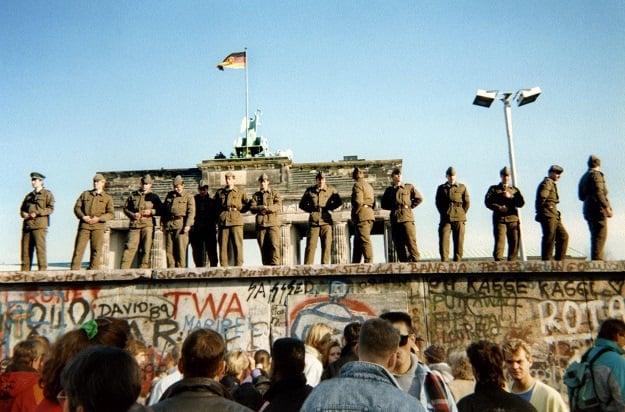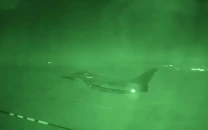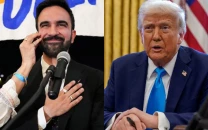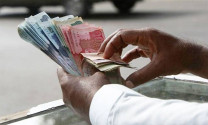1989: communist Eastern Europe crumbles
A look at the upheaval in Eastern Europe as Soviet-allied communist regimes fell one after the other

This file photo taken on November 11, 1989 shows a West Berliner preparing to hand over a FRG flag to East German Vopo policemen through a portion of the fallen Berlin Wall near the Brandenbourg Gate (Photo: AFP)
Here is a look back:
On May 2, liberal-leaning Hungary begins dismantling the electric alarm system and barbed wire that has sealed its border with Austria since 1966.
It is the first breach in the Iron Curtain - the heavily secured barrier between Eastern and Western Europe which includes the Berlin Wall.
 In this file photo taken on November 11, 1989, West Berliners crowd in front of the Berlin Wall early as they watch East German border guards demolishing a section of the wall in order to open a new crossing point between East and West Berlin, near the Potsdamer Square in Berlin (Photo: AFP)
In this file photo taken on November 11, 1989, West Berliners crowd in front of the Berlin Wall early as they watch East German border guards demolishing a section of the wall in order to open a new crossing point between East and West Berlin, near the Potsdamer Square in Berlin (Photo: AFP)In a highly publicised event on June 27, the Hungarian and Austrian foreign ministers use large pliers to cut through barbed wire separating their countries.
On September 10, Hungary opens its border to people wanting to leave communist East Germany to reach the democratic West. More than 50,000 flee.
November 9, 1989: the day that changed the world
On June 4, Poland's just-legalised Solidarity trade union sweeps the first partially democratic elections in the Eastern European bloc.
On August 24, it installs the first non-communist head of government in Eastern Europe in over 40 years when Solidarity's Tadeusz Mazowiecki becomes prime minister.
From September, Eastern German cities hold anti-communist demonstrations every Monday. The largest is on October 9, a candlelight procession of 70,000 people in Leipzig that attracts international attention.
In Berlin two days earlier, Soviet President Mikhail Gorbachev - undertaking reforms to liberalise communism - warns the Eastern German government against being too rigid in the face of calls for change.
 In this file photo taken on November 11, 1989, East German border guards stand on a section of the Berlin wall with the Brandenburg Gate in the background in Berlin (Photo: AFP)
In this file photo taken on November 11, 1989, East German border guards stand on a section of the Berlin wall with the Brandenburg Gate in the background in Berlin (Photo: AFP)Amid growing pressure, resistant hardline East German leader Erich Honecker is forced out on October 18.
He is replaced by Egon Krenz, the country's last hardline communist ruler.
In Hungary, the ruling Communist Party re-brands itself the Socialist Party in October.
Race to remember Berlin Wall victims, 30 years on
Thousands demonstrate on October 23, the anniversary of an anti-Soviet uprising crushed 33 years before, with many protesters brandishing flags from which communist symbols are cut out.
The same day, Hungary announces the end of communist rule and declares itself a republic.
On November 4, at least one million people demonstrate in East Berlin, three-quarters of its population, to demand greater freedom.
The government resigns three days later.
 Andreas Falge, one of the thousands of East Germans who crossed into West Berlin through the Bornholmer Strasse checkpoint on the evening of November 9, 1989, poses next to a photograph taken that very evening, which forms part of a memorial near the Boesebruecke (Boese bridge) which straddled the border (Photo: AFP)
Andreas Falge, one of the thousands of East Germans who crossed into West Berlin through the Bornholmer Strasse checkpoint on the evening of November 9, 1989, poses next to a photograph taken that very evening, which forms part of a memorial near the Boesebruecke (Boese bridge) which straddled the border (Photo: AFP)On November 9, communist border guards open the Berlin Wall after authorities unexpectedly allow free passage.
Over the next weekend, three million East Germans visit the West.
Euphoric Berliners celebrate through the night as the wall is demolished.
Politics and peace: World at war since fall of Berlin Wall, says Tariq Ali
On November 17, police launch a brutal crackdown on peaceful student protests in Prague.
It sparks the bloodless Velvet Revolution, led by playwright Vaclav Havel, which culminates with the Communists stepping down on November 24 after days of mass protests.
In December, a government of national entente is formed: Havel replaces communist President Gustav Husak.
 A photograph of a graffito reading: "Where's my file?" is seen at the entrance of the former headquarters of the Stasi (East German communist secret police), in Berlin (Photo: AFP)
A photograph of a graffito reading: "Where's my file?" is seen at the entrance of the former headquarters of the Stasi (East German communist secret police), in Berlin (Photo: AFP)Bulgaria's longtime communist dictator Todor Jivkov is ousted by his own party on November 10. A month later, the Bulgarian Communist Party gives up its right to rule and calls elections.
In Romania, strongman Nicolae Ceausescu is overthrown on December 22 after days of demonstrations and deadly clashes.
Convicted in a summary trial on charges including genocide and embezzlement, he and his wife Elena are executed by firing squad on December 25.



















COMMENTS
Comments are moderated and generally will be posted if they are on-topic and not abusive.
For more information, please see our Comments FAQ